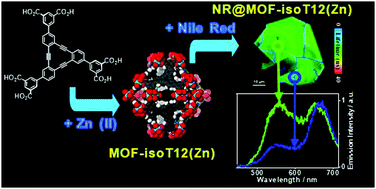Deciphering the behavior of a new MOF and its composites under light at ensemble and single crystal levels: relevance to its photonic applications†
Abstract
Metal–organic frameworks (MOFs) are being developed for a variety of applications ranging from gas storage and separation, photocatalysis, sensing and lighting to drug delivery and water capture. In the context of their photonic applications, herein, we report on the synthesis and characterization of the photobehavior of luminescent MOF-isoT12(Zn) and its composites with Nile Red (NR) at ensemble and single crystal levels. The used linker, isoT12H6, a highly fluorescent ligand, shows different spectra in solutions and solid state, governed by a room-temperature phosphorescence with a short lifetime (20–30 ns). The observed behavior agrees with TD-DFT calculations. MOF-isoT12(Zn) exhibits a rich dynamic, where excimers are photoproduced in 100 ps and decay in 17 ns, while intercrystal interactions produce aggregates of different photobehaviors. Time-resolved fluorescence lifetime imaging (FLIM) experiments at single crystal level reveal the presence of defects emitting in 4 ns. Powder X-ray and FLIM data indicate that these result from de-solvation, leading to a gradual partial loss of crystallinity. Efficient energy transfer (130 ps) occurs from MOF-isoT12(Zn) to surface-adsorbed NR molecules, providing a broad emission spectrum (470–750 nm) that can be tuned by adjusting the NR populations. At higher NR loading, homo-energy transfer was observed between the adsorbed molecules, while FLIM at the single crystal level reveals that NR preferentially interacts with the structural defects on the surface of the crystals. The presented results show the possibility of manipulating the photo-response of MOF-isoT12(Zn) upon the interaction of its external surface with the adsorbed fluorescent molecules. These observations should be of interest for potential lighting, photosensing, and imaging applications, and thus, for developing related nanotechnologies.



 Please wait while we load your content...
Please wait while we load your content...